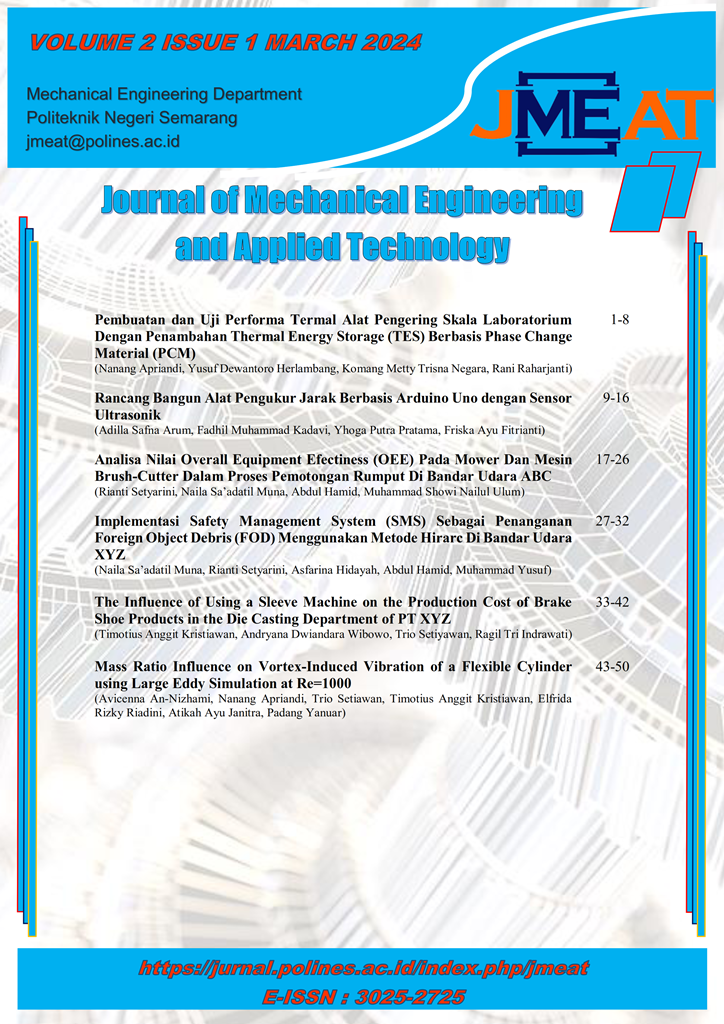Mass Ratio Influence on Vortex-Induced Vibration of a Flexible Cylinder using Large Eddy Simulation at Re=1000
DOI:
https://doi.org/10.32497/jmeat.v2i1.5498Keywords:
displacement, large eddy simulation, fluid-structure interaction, vortex-induced vibration, mass ratioAbstract
The study investigates the phenomenon of vortex-induced vibration (VIV) using Large Eddy Simulation (LES) at a Reynolds number of 1000, focusing on transitional flow conditions. LES has proven effective in understanding VIV across Reynolds number regimes, aiding in comprehending flow physics and mechanisms behind VIV. The research aims to contribute data for validating numerical models and informing engineering practices. The study employs the Navier-Stokes equation and the continuity equation to analyze fluid flow, treating it as incompressible due to negligible density changes. The three-dimensional incompressible momentum equation is discretized using the finite volume method within the spatial domain. Resolution of the pressure Poisson equation ensures compliance with free divergence conditions, enhancing computational fluid dynamics simulations' reliability. Validation of the fluid flow solver involves comparing computed drag force coefficients with established benchmarks, showing agreement within small discrepancies. The study delves into vibration behavior induced by cross flow at various reduced velocities (), noting distinct patterns ranging from irregularities at low to quasi-periodic behavior at higher values. Analysis of maximum cylinder displacement () across different reduced velocities and mass ratios underscores the complex relationship between system parameters and displacement dynamics. A consistent occurrence of y_max at a specific reduced velocity highlights its significance, while varying mass ratios affect displacement patterns, indicating the importance of understanding these dynamics for optimizing fluid-structure interaction systems.
References
W. Chen et al., “Investigation of vortex-induced vibrations of rotating cylinders with different surface roughnesses,” Physics of Fluids, vol. 36, no. 4, Apr. 2024, doi: 10.1063/5.0197691.
A. Teimourian and H. Teimourian, “Vortex Shedding Suppression: A Review on Modified Bluff Bodies,” Eng, vol. 2, no. 3. Multidisciplinary Digital Publishing Institute (MDPI), pp. 325”“339, Sep. 01, 2021. doi: 10.3390/eng2030021.
Bishop and Hassan, “The lift and drag forces on a circular cylinder oscillating in a flowing fluid,” Proc R Soc Lond A Math Phys Sci, vol. 277, no. 1368, pp. 32”“50, 1964, [Online]. Available: https://royalsocietypublishing.org/
P. W. Bearman, “Circular cylinder wakes and vortex-induced vibrations,” J Fluids Struct, vol. 27, no. 5”“6, pp. 648”“658, Jul. 2011, doi: 10.1016/j.jfluidstructs.2011.03.021.
P. W. Bearman, “VORTEX SHEDDING FROM OSCILLATING BLUFF BODIES,” 1984. [Online]. Available: www.annualreviews.org
T. Sarpkaya, “A critical review of the intrinsic nature of vortex-induced vibrations,” J Fluids Struct, vol. 19, no. 4, pp. 389”“447, 2004, doi: 10.1016/j.jfluidstructs.2004.02.005.
T. Sarpkaya, “Hydrodynamic Da .roping, Flow-Induced Osc llabons, and Biharmonic Response,” 1995. [Online]. Available: http://offshoremechanics.asmedigitalcollection.asme.org/
C. H. K. Williamson and R. Govardhan, “Vortex-induced vibrations,” Annu Rev Fluid Mech, vol. 36, pp. 413”“455, 2004, doi: 10.1146/annurev.fluid.36.050802.122128.
C. C. Feng, “THE MEASUREMENT OF VORTEX INDUCED EFFECTS IN FLOW PAST STATIONARY AND OSCILLATING CIRCULAR AND D-SECTION CYLINDERS,” 1968.
D. Brika A N and D. A. Laneville, “Vortex-induced vibrations of a long flexible circular cylinder,” 1993.
A. Khalak and C. H. K. Williamson, “MOTIONS, FORCES AND MODE TRANSITIONS IN VORTEX-INDUCED VIBRATIONS AT LOW MASS-DAMPING,” 1999. [Online]. Available: http://www.idealibrary.comon
M. Belloli, S. Giappino, S. Morganti, S. Muggiasca, and A. Zasso, “Vortex induced vibrations at high Reynolds numbers on circular cylinders,” Ocean Engineering, vol. 94, pp. 140”“154, Jan. 2015, doi: 10.1016/j.oceaneng.2014.11.017.
M. Zhao, L. Cheng, and L. Lu, “Vortex induced vibrations of a rotating circular cylinder at low Reynolds number,” Physics of Fluids, vol. 26, no. 7, Jul. 2014, doi: 10.1063/1.4886196.
R. Bourguet, “Vortex-induced vibrations of a flexible cylinder at subcritical Reynolds number,” J Fluid Mech, vol. 902, 2020, doi: 10.1017/jfm.2020.676.
E. Wang, W. Xu, X. Gao, L. Liu, Q. Xiao, and K. Ramesh, “The effect of cubic stiffness nonlinearity on the vortex-induced vibration of a circular cylinder at low Reynolds numbers,” Ocean Engineering, vol. 173, pp. 12”“27, Feb. 2019, doi: 10.1016/j.oceaneng.2018.12.039.
J. Gu, A. C. Fernandes, and J. S. Sales, “Alternative insight to understand the Reynolds number effects in vortex-induced vibration,” Marine Structures, vol. 69, Jan. 2020, doi: 10.1016/j.marstruc.2019.102686.
E. Konstantinidis, D. Dorogi, and L. Baranyi, “Resonance in vortex-induced in-line vibration at low Reynolds numbers,” J Fluid Mech, 2020, doi: 10.1017/jfm.2020.850.
S. Behara, B. Ravikanth, and V. Chandra, “Vortex-induced vibrations of three staggered circular cylinders at low Reynolds numbers,” Physics of Fluids, vol. 29, no. 8, Aug. 2017, doi: 10.1063/1.4998417.
W. Chen, C. Ji, J. Williams, D. Xu, L. Yang, and Y. Cui, “Vortex-induced vibrations of three tandem cylinders in laminar cross-flow: Vibration response and galloping mechanism,” J Fluids Struct, vol. 78, pp. 215”“238, Apr. 2018, doi: 10.1016/j.jfluidstructs.2017.12.017.
A. M. G. de Lima, B. S. C. da Cunha, A. R. da Silva, and L. F. F. Rodovalho, “Vortex-induced vibration analysis of viscoelastically mounted rigid circular cylinders in cross-flow at a moderate Reynolds number,” JVC/Journal of Vibration and Control, vol. 24, no. 13. SAGE Publications Inc., pp. 2688”“2700, Jul. 01, 2018. doi: 10.1177/1077546317733656.
S. K. Jordan and J. E. Fromm, “Oscillatory drag, lift, and torque on a circular cylinder in a uniform flow,” Physics of Fluids, vol. 15, no. 3, pp. 371”“376, 1972, doi: 10.1063/1.1693918.
G. Y. Dynnikova, “The lagrangian approach to solving the time-dependent navier-stokes equations,” Doklady Physics, vol. 49, no. 11, pp. 648”“652, Nov. 2004, doi: 10.1134/1.1831530.
Downloads
Published
Issue
Section
License
Authors who publish articles in this journal agree to the following terms:
The author owns the copyright and grants first publication rights to the Journal with work simultaneously licensed under a Creative Commons Attribution License which allows others to share the work with the work acknowledged and first published in this journal
Authors may enter into separate, additional contractual agreements for the non-exclusive distribution of the journal's published version of the work (for example, posting it to an institutional repository or publishing it in a book), with an acknowledgment of the first publication in this journal.
Authors are permitted and encouraged to upload their work online (for example, in an institutional repository or on an author's website) before and during the submission process, as this can lead to productive exchanges, as well as earlier citations and a larger number of citations of the published work. (See the impact of open Access).






